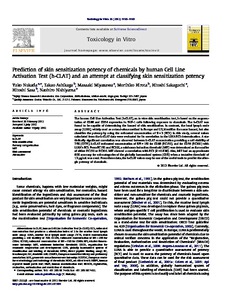Prediction of skin sensitization potency of chemicals by human Cell Line Activation Test (h-CLAT) and an attempt at classifying skin sensitization potency

Nukada, Yuko ; Ashikaga, Takao ; Miyazawa, Masaaki ; Hirota, Morihiko ; Sakaguchi, Hitoshi ; Sasa, Hitoshi ; Nishiyama, Naohiro
2012
26
7
1150-1160
chemicals ; risk assessment ; sensitization ; skin
Medicine - Toxicology - Health
http://dx.doi.org/10.1016/j.tiv.2012.07.001
English
Bibliogr.
"The human Cell Line Activation Test (h-CLAT), an in vitro skin sensitization test, is based on the augmentation of CD86 and CD54 expression in THP-1 cells following exposure to chemicals. The h-CLAT was found to be capable of determining the hazard of skin sensitization. In contrast, the local lymph node assay (LLNA), widely used as a stand-alone method in Europe and US, identifies the same hazard, but also classifies the potency by using the estimated concentration of SI = 3 (EC3). In this study, several values calculated from the h-CLAT data were evaluated for its correlation to the LLNA EC3 determination. A statistically significant correlation was observed between h-CLAT concentration providing a cell viability of 75% (CV75), h-CLAT estimated concentration of RFI = 150 for CD86 (EC150), and for CD54 (EC200) with LLNA's EC3. From EC150 and EC200, a minimum induction threshold (MIT) was determined as the smaller of either EC150 or EC200. MIT showed a correlation with EC3 (R = 0.638). Also, MIT had an approximate 80% accuracy for sub-categories of the globally harmonized system (GHS) when a tentative threshold of 13 ?g/mL was used. From these data, the h-CLAT values may be one of the useful tools to predict the allergic potency of chemicals."
Digital
The ETUI is co-funded by the European Union. Views and opinions expressed are however those of the author(s) only and do not necessarily reflect those of the European Union or the ETUI.